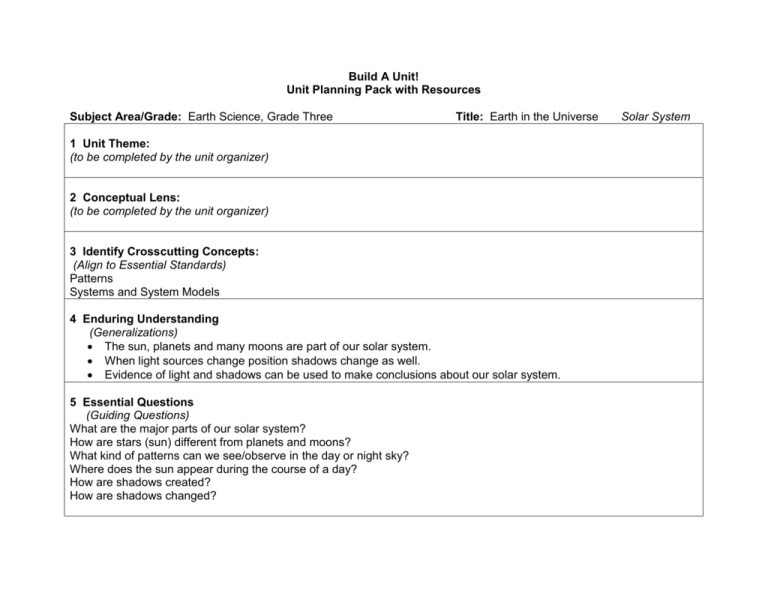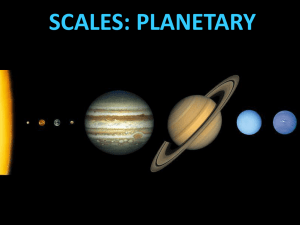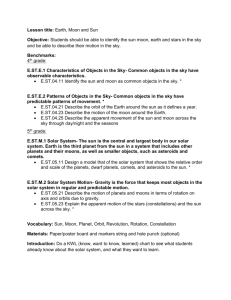Earth in the Universe Grade Three
advertisement

Build A Unit! Unit Planning Pack with Resources Subject Area/Grade: Earth Science, Grade Three Title: Earth in the Universe 1 Unit Theme: (to be completed by the unit organizer) 2 Conceptual Lens: (to be completed by the unit organizer) 3 Identify Crosscutting Concepts: (Align to Essential Standards) Patterns Systems and System Models 4 Enduring Understanding (Generalizations) The sun, planets and many moons are part of our solar system. When light sources change position shadows change as well. Evidence of light and shadows can be used to make conclusions about our solar system. 5 Essential Questions (Guiding Questions) What are the major parts of our solar system? How are stars (sun) different from planets and moons? What kind of patterns can we see/observe in the day or night sky? Where does the sun appear during the course of a day? How are shadows created? How are shadows changed? Solar System NC Science Essential Standards 3.E.1 Recognize the major components and patterns observed in the earth/moon/sun system. 3.E.1.1 Recognize that the earth is part of a system called the solar system that includes the sun (a star), planets, and many moons and the earth is the third planet from the sun in our solar system. 3.E.1.2 Recognize that changes in the length and direction of an object’s shadow indicate the apparent changing position of the Sun during the day although the patterns of the stars in the sky, to include the Sun, stay the same. Essential Terminology earth, moon, sun, planets, moon, solar system, change, pattern, shadow, position, length, direction GRAPHIC ORGANIZERS: (Some for teachers, some for students) Qwiki Earth http://www.qwiki.com/q/Earth Qwiki Moon http://www.qwiki.com/q/Moon Qwiki Solar System http://www.qwiki.com/q/Solar_System Sky Changes http://www.eduplace.com/science/hmsc/content/organizer/1/org_1d_9_4.pdf Teacher Examples http://amazing-space.stsci.edu/eds/tools/type/organizers.php.p=Teaching+tools%40%2Ceds%2Ctools%2C&a=%2Ceds Enchanted Learning graphic organizers blank http://www.enchantedlearning.com/graphicorganizers/ Science For All Americans (minimum ADULT content knowledge) The Universe Our solar system coalesced out of a giant cloud of gas and debris left in the wake of exploding stars about five billion years ago. Everything in and on the earth, including living organisms, is made of this material. As the earth and the other planets formed, the heavier elements fell to their centers. On planets close to the sun (Mercury, Venus, Earth, and Mars), the lightest elements were mostly blown or boiled away by radiation from the newly formed sun; on the outer planets (Jupiter, Saturn, Uranus, and Neptune), the lighter elements still surround them as deep atmospheres of gas or as frozen solid layers. In total, there are eight planets of very different size, composition, and surface features that move around the sun in nearly circular orbits. Around the planets orbit a great variety of moons and (in some cases) flat rings of rock and ice debris or (in the case of the earth) a moon and artificial satellites. Features of many of the planets and their moons show evidence of developmental processes similar to those that occur on the earth (such as earthquakes, lava flows, and erosion). There are also a great many smaller bodies of rock and ice orbiting the sun. Some of those that the earth encounters in its yearly orbit around the sun glow and disintegrate from friction as they plunge into the atmosphere—and sometimes impact the ground. Other chunks of rock mixed with ice have such long and off-center orbits that they periodically come very close to the sun, where some of their surface material is boiled off by the sun's radiation and pushed into a long illuminated tail that we see as a comet. Our still-growing knowledge of the solar system and the rest of the universe comes to us in part by direct observation but mostly through the use of tools we have developed to extend and supplement our own senses. These tools include radio and x-ray telescopes that are sensitive to a broad spectrum of information coming to us from space; computers that can undertake increasingly complicated calculations of gravitational systems or nuclear reactions, finding patterns in data and deducing the implications of theories; space probes that send back detailed pictures and other data from distant planets in our own solar system; and huge "atom smashers" that simulate conditions in the early universe and probe the inner workings of atoms. Most of what we believe we know about the universe must be inferred by using all these tools to look at very small slices of space and time. What we know about stars is based on analysis of the light that reaches us from them. What we know about the interior of the earth is based on measurements we make on or near its surface or from satellites orbiting above the surface. What we know about the evolution of the sun and planets comes from studying the radiation from a small sample of stars, visual features of the planets, and samples of material (such as rock, meteorites, and moon and Mars scrapings), and imagining how they got to be the way they are. Next Generation Science Standards Framework (adults) ESS1.B: EARTH AND THE SOLAR SYSTEM What are the predictable patterns caused by Earth’s movement in the solar system? The solar system consists of the sun and a collection of objects of varying sizes and conditions—including planets and their moons—that are held in orbit around the sun by its gravitational pull on them. This system appears to have formed from a disk of dust and gas, drawn together by gravity. Earth and the moon, sun, and planets have predictable patterns of movement. These patterns, which are explainable by gravitational forces and conservation laws, in turn explain many large-scale phenomena observed on Earth. Planetary motions around the sun can be predicted using Kepler’s three empirical laws, which can be explained based on Newton’s theory of gravity. These orbits may also change somewhat due to the gravitational effects from, or collisions with, other bodies. Gradual changes in the shape of Earth’s orbit around the sun (over hundreds of thousands of years), together with the tilt of the planet’s spin axis (or axis of rotation), have altered the intensity and distribution of sunlight falling on Earth. These phenomena cause cycles of climate change, including the relatively recent cycles of ice ages. Gravity holds Earth in orbit around the sun, and it holds the moon in orbit around Earth. The pulls of gravity from the sun and the moon cause the patterns of ocean tides. The moon’s and sun’s positions relative to Earth cause lunar and solar eclipses to occur. The moon’s monthly orbit around Earth, the relative positions of the sun, the moon, and the observer and the fact that it shines by reflected sunlight explain the observed phases of the moon. Even though Earth’s orbit is very nearly circular, the intensity of sunlight falling on a given location on the planet’s surface changes as it orbits around the sun. Earth’s spin axis is tilted relative to the plane of its orbit, and the seasons are a result of that tilt. The intensity of sunlight striking Earth’s surface is greatest at the equator. Seasonal variations in that intensity are greatest at the poles. Grade Band Endpoints for ESS1.B By the end of grade 2. Seasonal patterns of sunrise and sunset can be observed, described, and predicted. By the end of grade 5. The orbits of Earth around the sun and of the moon around Earth, together with the rotation of Earth about an axis between its North and South poles, cause observable patterns. These include day and night; daily and seasonal changes in the length and direction of shadows; phases of the moon; and different positions of the sun, moon, and stars at different times of the day, month, and year. Some objects in the solar system can be seen with the naked eye. Planets in the night sky change positions and are not always visible from Earth as they orbit the sun. Stars appear in patterns called constellations, which can be used for navigation and appear to move together across the sky because of Earth’s rotation. Unpacked Content (for students) 3.E.1.1 Students know that we live on a planet that is part of a solar system. Students know that a solar system includes a star and planets, and other objects. The planets and other objects revolve around the star. Students know that in our solar system Earth is the third planet from the sun. 3.E.1.2 Students know that the Sun and stars in the sky move in consistent patterns. Students know that shadows are created when objects block light. Students know that as the Sun changes its apparent position in the sky, the shadows cast by objects will change. Students know that the Earth rotates on its axis and revolves around the Sun Identify Student Misconceptions * Formative probes should be adapted to a format that is suitable for your grade level and students *Construct formative assessment probes – see ‘how to’ on pages 85, 102, and 183 in Science Formative Assessment by Page Keeley. Use formative probes: Uncovering Student ideas in Science, Volumes 1-4, by Page Keeley Volume 2: Darkness at Night p. 172 Elicits student ideas about the day/night cycle. Volume 3: Me and My Shadow p.185 Elicits student ideas about light and shadows and how shadows change throughout the day Volume 3: Where Do Stars Go? P.191 Elicits student ideas about where stars are during daytime. Formative Assessment Probes (articles, how-to, free-online) by Page Keeley, et al http://pal.lternet.edu/docs/outreach/educators/education_pedagogy_research/assessment_probes_uncovering_student_id eas.pdf http://www.ode.state.or.us/teachlearn/subjects/science/resources/msef2010-formative_assessment_probes.pdf North Carolina Connections: (local and state resources) Morehead Planetarium Morehead Planetarium and Science Center | CB #3480 | UNC | Chapel Hill, NC 27599 Cummins Planetarium Rocky Mount Children’s Museum North Carolina Museum of Natural Sciences 11 West Jones St. Raleigh, NC 27601 919-733-7450 (Astronomy Days) North Carolina Museum of Life and Science 433 West Murray Avenue (street address), P.O. Box 15190, Durham, NC 27704, (919) 220-5429 SciWorks, the Science Center and Environmental Park of Forsyth County Enjoy interactive, hands-on special exhibits and programs in spacious exhibit halls. 400 West Hanes Mill Rd., WinstonSalem, (336) 767-6730 TEACHING Resources Learn about the sun, light & shadows as you experiment with different light sources and objects in this fun, interactive science activity for kids http://sciencekids.co.nz/gamesactivities/lightshadows.html Astronomy with a Stick. Students measure shadows over various lengths of time to determine patterns. This has excellent background knowledge for teacher and should be modified for third grade students. http://www.nsta.org/publications/interactive/aws-din/aws.aspx Shadows and writing http://www.readwritethink.org/classroom-resources/lesson-plans/casting-shadows-across-literacy-1016.html?tab=1#tabs Lessons with Making Shadows http://sciencenetlinks.com/lessons/sky-2-shadows/ http://sciencenetlinks.com/lessons/sky-3-modeling-shadows/ Patterns of stars in night sky (#4 and #7) (patterns are due to the observer’s location and relative motion) http://ecuip.lib.uchicago.edu/diglib/science/cultural_astronomy/interactives/polaris/where_is_polaris.html Solar system fact cards http://amazing-space.stsci.edu/resources/explorations/trading/directions.html Changing shadows activity p.10, 11 http://www.learner.org/workshops/sheddinglight/materials/pdf/shlos1.pdf NASA eClips Our World: Video: Go to the website and type in What is the Solar System? Look for date Nov.17,2010 http://www.nasa.gov/audience/foreducators/nasaeclips/search.html Shadow tricks http://www.teachersdomain.org/resource/lsps07.sci.phys.energy.cgshadow/ Smart Exchange http://exchange.smarttech.com/search.html A directory of Smart Board lessons that teachers can download and use. Teachers Domain http://www.teachersdomain.org/ Free digital media for educational use. Quick-Write Prompts 1) Using words and pictures create an informational solar system book. 2) With guidance and support from adults create a graphic organizer comparing components of the solar system. 3) Use digital tools to create a class book showing how different object’s shadows change over time. 4) Write about a favorite constellation. 5) Write an imaginary narrative about a day that your shadow ran away. READING Resources (scroll to informational text) Shadow book selections http://www.readwritethink.org/files/resources/lesson_images/lesson1016/booklist.pdf http://www.ncpublicschools.org/docs/acre/standards/common-core-tools/exemplar/ela.pdf Informational text magazine articles vary by month http://www.nationalgeographic.com/ngyoungexplorer/1105/readstory.html









